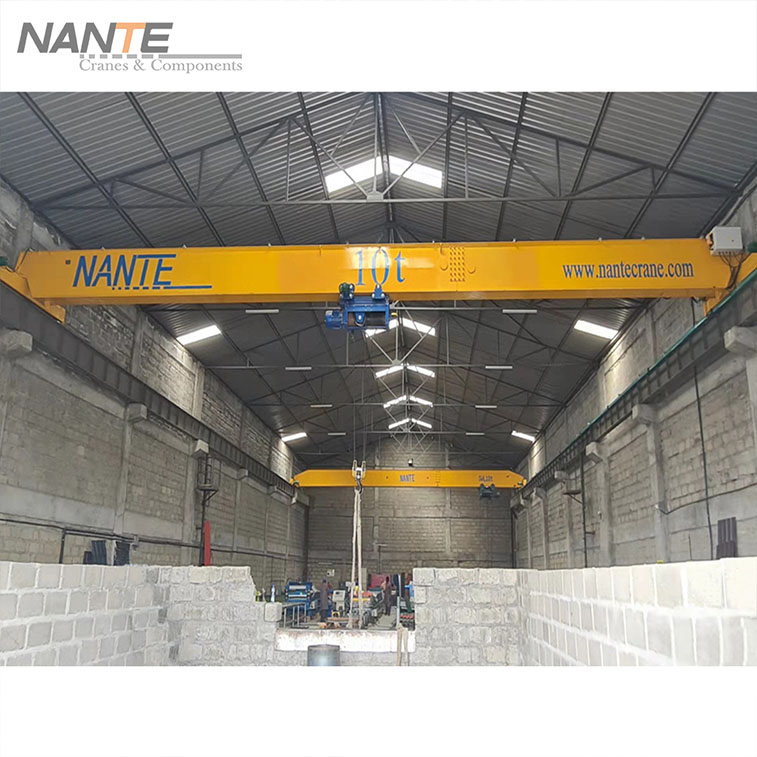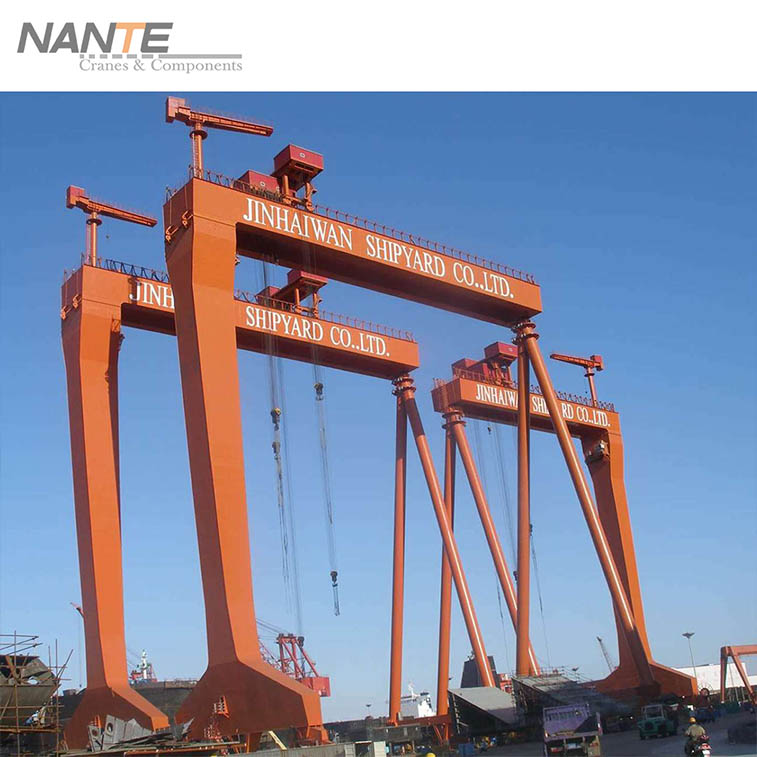Rethinking Industrial Machinery: Overhead Crane vs Gantry Crane
Date: 2024-04-26 Share:
Exploring the Overhead Crane
In the realm of industrial machinery, the overhead crane stands as a stalwart solution for lifting and transporting heavy loads with precision and efficiency. Understanding the design, mechanics, and advantages of this crane type is essential for businesses seeking optimal operational capabilities.
The Design and Mechanics of Overhead Cranes
One of the defining features of overhead cranes is their structural integration into buildings. These cranes are typically attached to the interior structure of a facility, utilizing double beams, electric hoists, trolleys, end carriages, and an electric control system. This integration allows for seamless movement of large, heavy loads through a facility’s overhead space.
Overhead crane systems are engineered to lift, lower, and move bulky loads horizontally within a facility’s overhead space. The operator controls the crane’s movement in multiple directions: laterally (side to side), vertically (up and down), backwards, and forwards. While these cranes offer exceptional load capacity and precise movement control, they are limited by their fixed installation within a building’s structure.

Advantages of Using Overhead Cranes
The advantages of employing overhead cranes are multifaceted. These cranes can be customized to suit specific requirements such as lifting height, load capacity, and span. Additionally, they are designed for heavy-duty applications where high load capacity and space efficiency are paramount. Factors such as dual hoist options, radio remote control, custom variable frequency control with up to 1000:1 control ratio further enhance their operational capabilities.
Overhead bridge cranes also adhere to industry specifications such as those set by the Crane Manufacturers Association of America (CMAA), ensuring that they meet rigorous safety standards while providing reliable performance in industrial settings.
By comprehensively exploring the design intricacies and operational advantages offered by overhead cranes, businesses can make informed decisions regarding their industrial machinery investments.
Understanding the Gantry Crane
In the realm of industrial machinery, the gantry crane emerges as a versatile and mobile solution for lifting and transporting heavy loads across diverse industrial settings. Understanding the unique structure, mobility, and applications of gantry cranes is essential for businesses seeking flexible and efficient lifting solutions.
The Unique Structure of Gantry Cranes
Self-Supporting Framework
A defining feature of gantry cranes is their self-supporting framework, which sets them apart from overhead cranes. Unlike overhead cranes that are fixed to a building’s structure, gantry cranes are designed with their own supporting framework. This allows them to be easily relocated or even transported to different locations, adapting to changing operational needs and applications. The self-sufficiency of gantry cranes enhances their flexibility and maneuverability in various industrial environments.
Mobility and Versatility
Gantry cranes offer greater mobility and versatility compared to traditional overhead cranes. Their adjustable dimensions, including placement along the I beam (span), height, and base width, make them adaptable to different working environments. This level of adjustability enables gantry cranes to maneuver around work areas with ease, enhancing operational efficiency while ensuring workplace safety.

Why Choose a Gantry Crane?
The decision to choose a gantry crane over an overhead crane is driven by its unparalleled mobility and flexibility. These attributes make gantry cranes the ideal choice for a wide range of lifting applications across industries such as construction, shipping, storage, and more. In shipyards, where extremely heavy loads and ship parts need to be moved, the mobility and versatility of gantry cranes make them indispensable assets.
The flexibility of gantry cranes also positions them as valuable tools for small and large industrial use. They are often used in place of overhead cranes when specific operational requirements call for enhanced maneuverability and adaptability. Additionally, gantry cranes find extensive application in warehouses, shipping docks, railroad yards, port terminals due to their weather-protective devices such as windproofing, rain covers, lightning protection that enable outdoor usage.
The load capacity, mobility, and flexibility of gantry cranes have made them an ideal choice for shipping container movement. Their ease of use enhances functionality while streamlining loading processes in various industrial settings.
Gantry cranes have greater maneuverability and flexibility due to their self-supporting nature. They can be easily dismantled and moved both externally and internally according to changing operational needs. This adaptability makes them invaluable assets across industries where dynamic lifting requirements are prevalent.
Key Differences Between Overhead and Gantry Cranes
When considering industrial lifting solutions, understanding the difference between overhead and gantry cranes is crucial for selecting the most suitable equipment to meet specific project demands. Each type of crane offers distinct advantages and applications, catering to diverse industrial needs.
Structural Differences and Installation
The main difference between these two types of cranes lies in their structural integration and installation. Gantry cranes are designed with a self-supporting framework, allowing them to be easily relocated or transported to different locations. In contrast, overhead cranes are attached to the interior structure of a building, utilizing double beams, electric hoists, trolleys, end carriages, and an electric control system. This fixed installation within a building’s structure limits their mobility compared to gantry cranes.
Understanding what your project requires from a crane will help you select equipment that can best meet your project’s demands and will quickly narrow down your options. Factors such as the weight being lifted, span requirements, frequency of use, indoor or outdoor usage, and the size of the building play a pivotal role in determining whether an overhead or gantry crane is more suitable for a specific application.
Applications and Suitability
Gantry cranes offer greater mobility and flexibility compared to traditional overhead cranes. Their adjustable dimensions make them adaptable to different working environments. While gantry cranes may not be as capable as overhead cranes in terms of load capacity, typically lifting loads of up to 15 tons, their versatility makes them suitable for a wide range of applications across industries such as construction, shipping, storage, and more.
On the other hand, overhead cranes are ideal for heavy-duty applications in industries where high load capacity and space efficiency are essential. The success of a project depends on selecting the right crane based on specific operational requirements. For example, moving a liquid-filled tank will require special lifting conditions compared to moving a concrete block or a heavy machine.
Industry-Specific Uses
The choice between overhead and gantry cranes often depends on industry-specific needs. Gantry cranes find extensive application in warehouses due to their weather-protective devices such as windproofing, rain covers, lightning protection that enable outdoor usage. They are also invaluable assets in shipyards for moving extremely heavy loads and ship parts due to their mobility and versatility.
In comparison,overhead cranes are commonly used in manufacturing facilities where heavy loads need to be moved with precision within limited space constraints. Their ability to seamlessly integrate into existing building structures makes them well-suited for indoor operations across various industries.
Cost and Space Considerations
Cost-effectiveness is another key consideration when choosing between overhead and gantry cranes. While gantry cranes offer unparalleled flexibility at relatively lower costs due to their self-supporting nature requiring minimal structural modifications,overhead cranes may involve additional expenses related to structural integration into buildings.
Furthermore,overhead bridge cranes, with their ability to maximize vertical space utilization within facilities while offering high load capacities,may be preferred when space efficiency is paramount in industrial settings.
By carefully evaluating these structural differences,application suitability,cost considerations,and industry-specific uses,businesses can make informed decisions regarding industrial machinery investments that align with their operational requirements while optimizing productivity.
Applications and Choosing the Right Crane for Your Needs
In the realm of industrial operations, selecting the appropriate crane type is pivotal to ensuring seamless and efficient lifting solutions that align with specific project demands. Both overhead cranes and gantry cranes offer distinct applications and advantages, catering to diverse industrial needs.
Overhead Crane Applications
Overhead cranes are widely utilized in manufacturing facilities, where heavy loads need to be moved with precision within limited space constraints. Their ability to seamlessly integrate into existing building structures makes them well-suited for indoor operations across various industries. These cranes are commonly employed in automotive assembly lines, steel production plants, and aerospace manufacturing facilities due to their high load capacity and precise movement control capabilities.
Furthermore, overhead bridge cranes are indispensable assets in warehouses where vertical space utilization is paramount. Their ability to maximize space efficiency while offering high load capacities makes them ideal for lifting and transporting heavy materials within confined storage areas. The adaptability of overhead cranes also extends to construction sites, where they facilitate the movement of heavy construction materials such as steel beams and precast concrete components.
Gantry Crane Applications
On the other hand, gantry cranes find extensive application in a wide range of industrial settings due to their unparalleled mobility and flexibility. In shipyards, these cranes play a crucial role in moving extremely heavy loads and ship parts with ease, leveraging their self-supporting framework for enhanced maneuverability. Additionally, gantry cranes are valuable assets in warehouses and shipping docks where outdoor usage is prevalent. Their weather-protective devices such as windproofing, rain covers, and lightning protection enable them to operate effectively in open environments.
Comparing Use Cases
When comparing use cases between overhead and gantry cranes, it becomes evident that each type offers unique advantages based on specific operational requirements. While overhead cranes excel in indoor applications where space efficiency is essential, gantry cranes prove invaluable for outdoor usage across industries such as shipping, construction, and storage.
Nante Crane is a leading Chinese company specializing in the design and manufacturing of cranes and crane components. We offer a comprehensive range of products to meet various demands, including Overhead Cranes and Gantry Cranes. The Overhead Crane options include Single Girder and Double Girder models with different lifting capacities. The Gantry Crane options include Single Girder and Double Girder models as well. Nante Crane’s products are known for their reliable and excellent performance, and We are widely used in industries such as manufacturing, logistics, mining, and energy. The company has a strong focus on continuous innovation and upgrading technologies to meet the demands of the industrial manufacturing 4.0 era. Nante Crane also has a reliable quality management system and provides full project life cycle services to its customers. With a global sales and service network, Nante Crane serves customers from around the world.
Conclusion: Reflecting on the Future of Industrial Machinery
In conclusion, the comparison between overhead and gantry cranes underscores the significance of making informed decisions when selecting industrial machinery. Overhead cranes are better suited for heavy-duty applications in industries such as manufacturing, steel production, and automotive assembly. Their ability to seamlessly integrate into existing building structures makes them well-suited for indoor operations where space efficiency is paramount. On the other hand, gantry cranes have become important in the construction industry due to their mobility and load capacity, allowing for rapid assembly and removal, making them an ideal lifting solution. Gantry cranes are more versatile and can be used in a wider range of industries, including construction, shipping, and warehousing.
 English
English






